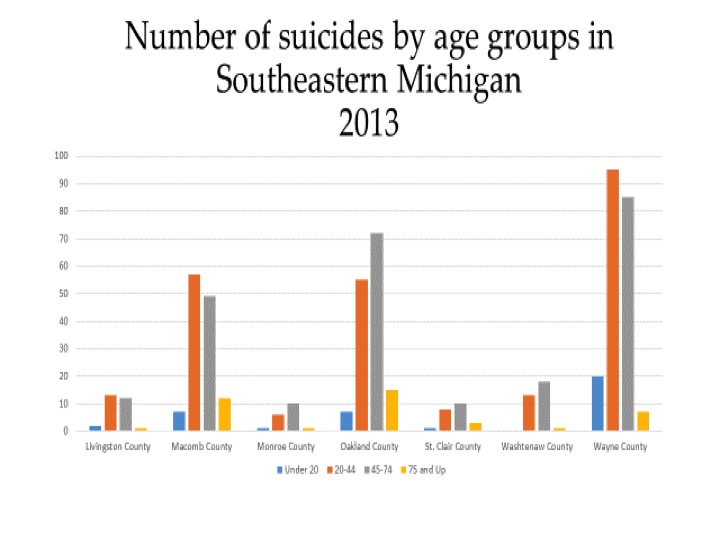Nationally, the suicide rate was 12.1 suicides per 100,000 residents in 2013, according to the Centers for Disease Control, and statewide it was 12. 9 per 100,000 people, according to the Michigan Department of Health and Human Services. However, in Southeastern Michigan we had three counties—Livingston, Macomb and St. Clair—that exceeded this rate. Livingston County had the highest rate in the region at 15.4 per 100,000 residents, with 28 suicides in the county in 2013. Macomb County had the second highest rate 14.8 (125) and St. Clair County had the third highest rate at 13.6 (22) in the region. In the seven counties throughout the region, and in the state overall, suicide was ranked as one of the top 10 causes of death in 2013.
While only certain cities throughout the region had suicide numbers available through the Michigan Department of Health and Human Services, we do know that Detroit had the largest overall number of suicides at 57 and Warren had the second highest number at 34; these are the first and third largest cities in the state, therefore when looking at total numbers (not the rate) it is not unexpected that they would also be the highest. The Detroit rate is below the state rate, however, at 12.3.
Nationally, the suicide rate was 12.1 suicides per 100,000 residents in
Suicide rates have been climbing at the state-level and in areas throughout the region. Michigan’s suicide rate is currently the highest it has been since at least 1980 (the first year this data is accessible online), according to the Michigan Department of Health and Human Services. From the 2004-2013, Macomb County had a suicide rate higher than that of the state for seven out of 10 years. In 2013, Macomb’s suicide rate was 14.8, an increase from 11.4 in 2004. Oakland County’s rate increased from 9.9 to 12.3 during that time frame (peaking at 13.9 in 2012), and Wayne County’s rate increased from 9.3 to 11.5 between 2013 and 2014.
In Oakland County, the rate peaked at 12.9 in 2012 and only slightly decreased to 12.3 in 2013. Director of Clinical Services for Health Management Systems of America Beth Combs cited the recession as one of the reasons for the national suicide rate climbed in the past 10 years, according to a 2013 Oakland Press article. She said the loss of a job, particularly for men between the ages of 35 and 55, can leave many feeling hopeless. However, a struggling economy does not solely cause one to take their own life, if at all. Suicide can be caused by mental health issues, feelings of hopelessness and/or loneliness, divorce, bullying, violence and several other issues, according to the Michigan Association for Suicide Prevention.
Annual rates for Livingston, Monroe, St. Clair and Washtenaw counties were not included in the below graph because the Michigan Department of Health and Human Services only had five year rolling averages for those counties.
The suicide rate has nearly doubled for middle-aged Americans in the past decade, according to an Oakland Press article. Above we see that throughout Southeastern Michigan counties in 2013, the number of suicides were either highest among those 20-44 or 45-74 (this is how age categories are broken down by the Michigan Department of Health and Human Services). Livingston, Macomb and Wayne counties had the highest number of suicides in the 20-44 category while Monroe, Oakland, St. Clair and Washtenaw had the highest number in 45-74 category. At the national level, according to the Centers for Disease Control, the age group with the highest suicide rate (19.1) was those between the ages of 45 and 64.
According to the American Foundation of Suicide Prevention, adolescents consistently have lower suicide rates than other age groups.
In Michigan, while support groups for those suffering from suicidal thoughts and survivors of suicide do exist, mental health funding as a whole has been cut. In 2014, according to a Voice News article, Macomb County cut services to about 1,300 people and St. Clair County cut services to about to about 300. Overall, about $100 million was cut from the state’s mental health system in fiscal year 2014. In Macomb County, due to the state and Medicaid funding cuts, the county’s mental health authority cut its Survivors of Suicide (SOS) program and must rely on volunteers to staff its crisis center. Through general fund appropriations Macomb County has been able to re-establish the SOS program by contracting with an outside party. The Oakland County Community Mental Authority has taken a different route to promote suicide awareness prevention and support by a securing a five-year, $200,000 grant from the Substance Abuse and Mental Health Service Administration.
Despite monies being found outside of state funding to support suicide prevention, support and awareness programs we must be aware that rates are increasing locally and throughout the state as state funding for mental health services is declining.




